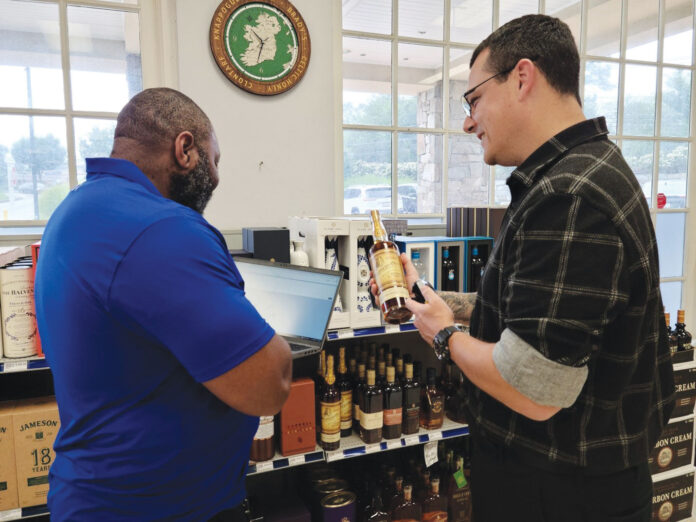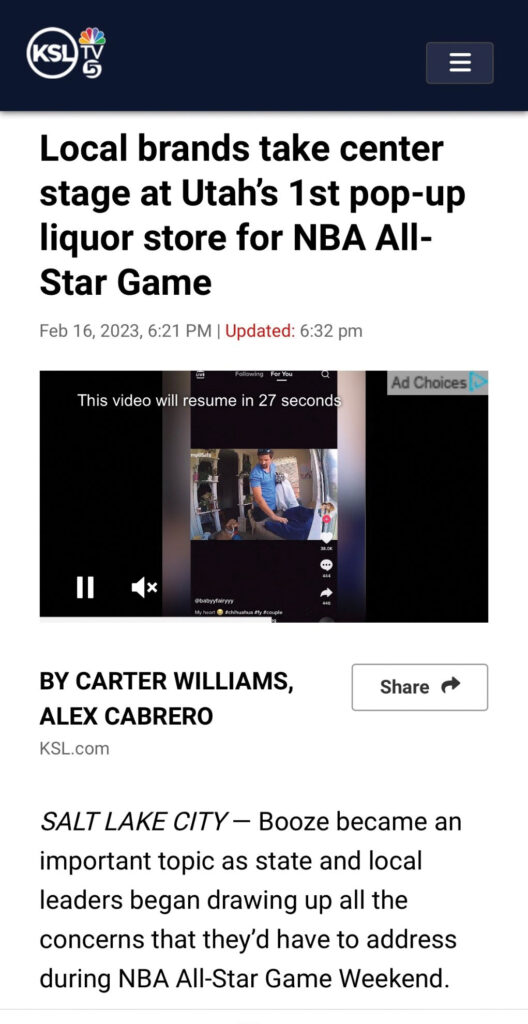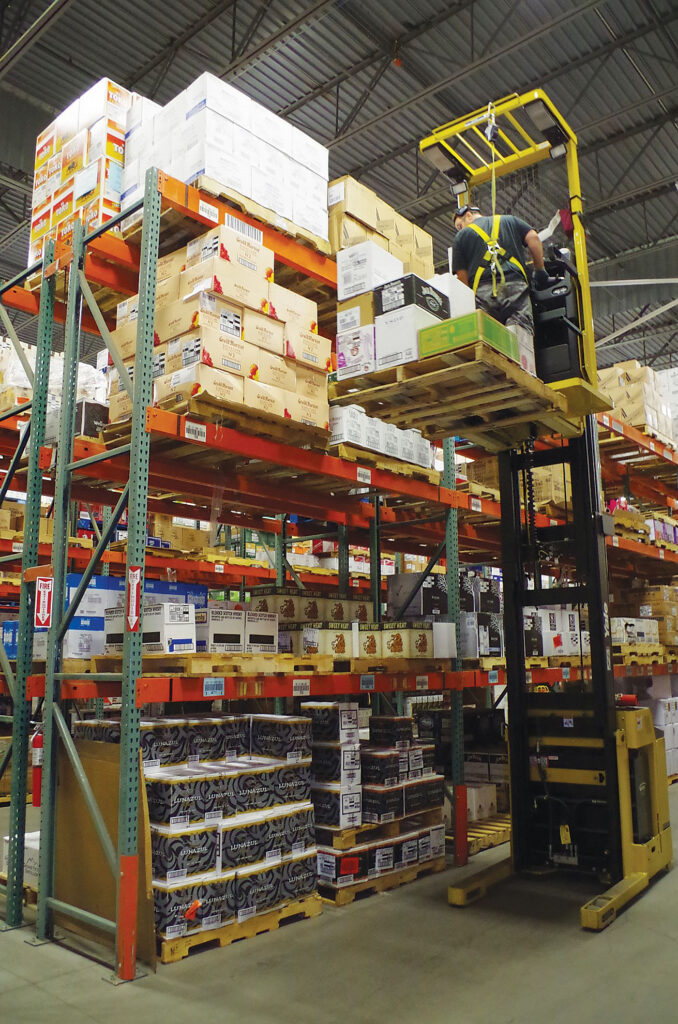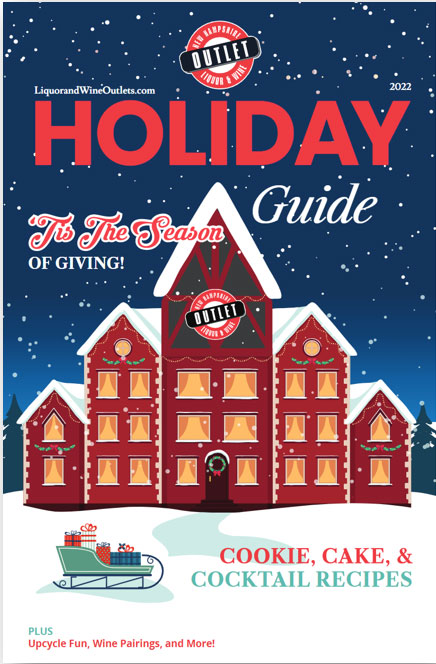The StateWays Magazine Control State Best Practices Awards launched in 2015 to recognize control state agencies that lead the industry in innovation, education and enforcement.
Best Enforcement Program
Montgomery County Alcohol Beverage Services
By Krystina Skibo
In the last year, Montgomery County Alcohol Beverage Services has consolidated and expanded its loss prevention efforts into a comprehensive Inventory Control Loss Prevention Unit.
With the addition of a manager and three field officers, ABS has strategized the approach, written new policies, implemented user-friendly systems and increased technologies to prevent loss caused by theft, fraud, wasteful practices and operational vulnerabilities.
ICLPU started with internal business partnerships, including the retail and wholesale divisions, to analyze open/close procedures, breakage, shoplifting, customer service, record keeping and information technology. The unit then moved to external partnerships, including law enforcement, the National Alcohol Beverage Control Association and the employee labor union, for additional perspectives.
“People initially think of shoplifting when they consider loss prevention, but this program takes a comprehensive view of the ways revenue can be lost and recovered,” says Montgomery County Alcohol Beverages Services Director Kathie Durbin. “The program addresses theft, but it also helps prevent fraud, wasteful practices and operational vulnerabilities. With the addition of a manager and three field officers, we will continue to assess stress points, like retail procedures, supply chain issues, shipping and receiving practices and inventory management. Ultimately, this program will ensure ongoing accountability and support for the community we serve.”
Within a few months, ICLPU developed a case management system that allows ABS employees to submit incident reports. With this information, field officers then investigate incidents and draft resolution reports that include metrics, media reports and narratives which are useful to the Police Department and State’s Attorneys.
Their reports contribute to arrests and prosecutions, improvements to operations and identification of loss trends. Ultimately, this data serves to increase awareness, drive change, improve collaboration and create a safer environment for employees and customers.
As an example of data-driven change, ICLPU fully revamped the department’s video monitoring strategy and technology. Doing so allows for high-definition images and video where it matters.
Using data collected by field officers, cameras are deployed in strategic locations with specific views of product and areas. This allows for ease of review, and reduces the amount of data exported per incident. Using up-to-date technology and techniques also allows for increased data retention on digital video servers, which in turn provides an extended date range of available footage. Not only does this assist ICLPU, but the department’s law enforcement partners are also thankful if video evidence is needed and available for investigations.
ICLPU has also worked very closely with the retail operations and information technology teams to design, develop and implement a new point-of-sale and inventory management system. Over the last six months, ICLPU has provided insight and experience to systems development teams to revamp ABS’ cash handling process, “over and short” reporting and inventory management process and reporting.
ICLPU’s involvement in the development of these systems and processes will continue to be essential in identifying and controlling vulnerabilities as they relate to sales terminals and inventory.
There is a lot of work ahead for ICLPU, but with its now-centralized resources and expertise, the unit is poised to achieve reduction in shoplifting events, product loss, point-of-sale errors and system/operational vulnerabilities. Also, it will increase efficiency of product and cash handling, thus reducing loss and exposure to potential vulnerabilities.
Best Stakeholder Outreach Program
Utah Department of Alcoholic Beverage Services
By Krystina Skibo
In June of 2022, Utah’s Department of Alcoholic Beverage Services (DABS) gave itself a service-first facelift with a rebranding launch, complete with a new name and new mission.
The new working mission statement is a complement to the longstanding mission statement defined in Utah state statute: “The department proudly serves all Utahns, whether or not they choose to drink alcohol. It also financially supports crucial government services, local businesses and tourism, and prioritizes alcohol prevention education for the health and safety of all Utahns.”
After the rebranding launch, DABS sought to continue its service-first drumbeat, capitalizing on earned media opportunities to validate a cultural shift in the department. A lack of public trust in the department means that third-party validators (media, external stakeholders) are crucial to its message resonating.
Throughout this effort, Utah DABS observers are noting positive change in the department, specifically in its commitment to support local businesses — licensees and manufacturers. DABS tracks the progress with earned media coverage and anecdotal feedback from licensees, manufacturers and other stakeholders.
“The increased media coverage acts as a third-party verifier that confirms the department’s efforts to improve customer service, not only to state store customers, but also to licensees and permittees that depend on the Utah DABS to safely, legally and efficiently run their businesses and events,” says Michelle Schmitt, Communications Director at DABS. “We want people to know that our department recognizes the value that these businesses and organizations provide for our state’s culture and economy, and we want to support them in being successful.”
DABS gives back to the community directly through government funding, but they also take the time to support those that seek out the agency’s resources.
In fiscal year 2022, the DABS generated $198.66 million in revenue to pay for statewide services like transportation and infrastructure, health, education, public safety, school lunches for kids and underage drinking prevention. The department also generated $31.23 million in sales taxes split between the state and local communities where DABS retail stores are located, according to a DABS press release.
Due to proper fiscal planning, the DABS increased pay for full-time store and warehouse employees across the board by $2 more per hour. The pay raise is in addition to the 3.5% increase for all state employees in FY 2022.
“The news coverage, coupled with more direct outreach to stakeholders, advances overall department goals as we work with state legislators, local governments, industry representatives and the food and beverage hospitality community,” Schmitt says.
Best Responsible Consumption Program
Alabama ABC Board
By Krystina Skibo
In 2013, the Alabama ABC Board developed the Under Age, Under Arrest program to bring awareness to and discourage underage and binge drinking. Geared towards middle school and high school students, the program is a 55-minute presentation that highlights the dangers and the legal, social and physical consequences of underage drinking.
“With the assistance of the National Alcohol Beverage Control Association, we developed our anti-underage drinking and binge drinking awareness and education program — Under Age, Under Arrest,” says Dean Argo, Manager of Government Relations & Communications, Alabama Alcoholic Beverage Control Board. “We partnered with Mothers Against Drunk Driving (MADD), the Alabama Law Enforcement Agency (State Troopers), and the Alabama Citizens Action Project to ensure that middle, junior high and high school students received factual information about an issue that was plaguing schools all over Alabama.”
Since its inception, more than 200,000 Alabama middle, junior, and high school students have participated in Under Age, Under Arrest events. As of May 2023, the program has presented more than 550 educational sessions and reached more than 225,000 Alabama students.
“Underage drinking statistics have shown a decrease over the last few years,” Argo says. “We strongly believe that in Alabama, at least, the Alabama ABC Board’s Under Age, Under Arrest program is playing a role in that reduction. The real-world information, explanation about Alabama laws, and the consequences of breaking those laws can have, as well as the real-life account of a mother whose family and life was ripped apart because of a bad decision someone made, is having a positive impact in our state.”
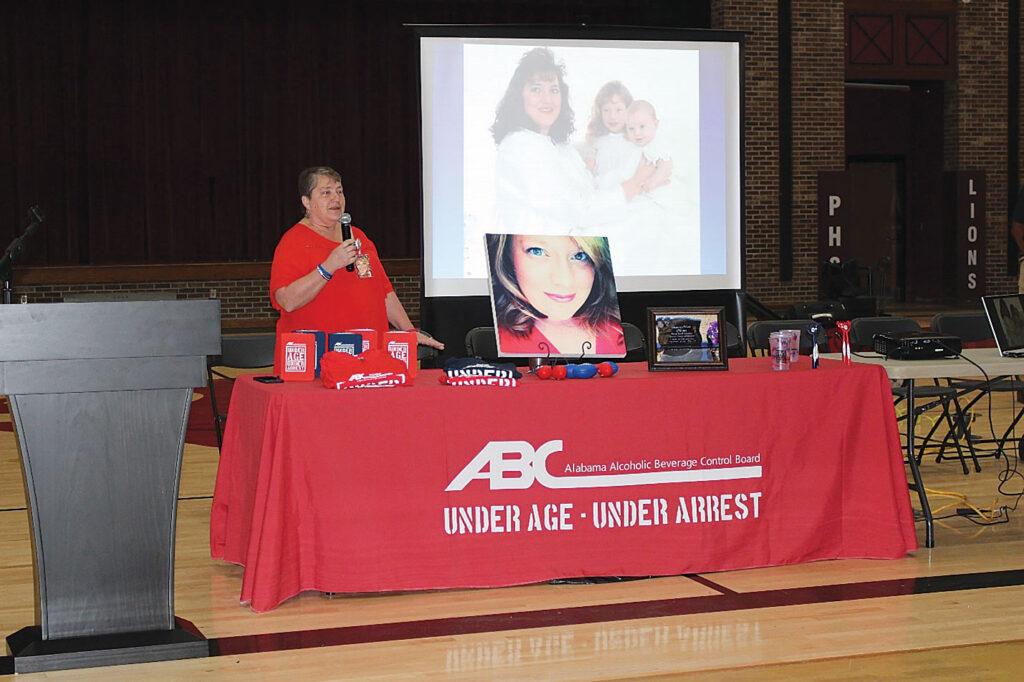
The program opens with the ABC Board offering students an explanation of the problem and a few statistics to back up the need for a solution. The State Trooper typically explains the consequences of being arrested for consumption, possession and/or attempting to purchase alcohol, before allowing students to wear “Drunk Goggles” while performing routine tasks or a field sobriety test. The MADD volunteer then closes the program with her personal story of how she lost a loved one or was involved in an alcohol-related crash.
“We have giveaways (t-shirts, foam footballs, cups, pens, notebooks, screen cleaners and thumb drives, all with the Under Age, Under Arrest logo on them), and we give each student a flier with additional information about underage drinking,” Argo says. “The students enjoy the goggle demonstration, but there usually isn’t a sound made or many dry eyes once the MADD volunteer speaks.”
During the first year, the Alabama ABC Board presented seven programs. What it lacked in actual program numbers, it gained through the educator’s network. Word quickly spread about the free 55-minute assembly-style program, and after the second year, an introductory letter went out to every middle, junior high and high school principal and counselor in the state.
“I hand-signed every one of the 1,800 letters we mailed,” Argo says. “We used the letters to fully explain the program and highlight the fact that it is free, and that we would come present on a day and time that best fit their schedules. We’ve added more and more programs each year since. A large majority of our presentations are at schools where we have presented in the past.”
Best Off-Premise Partnership
Ohio Division of Liquor
By Kyle Swartz
This past year, the Ohio Division of Liquor (OHLQ) expanded its consumer offerings to host several large-scale events, including launching the highly successful “Liquordation” and “Single Barrel Saturday” programs.
As a result of these achievements, the OHLQ won our Best Off-Premise Partnership Best Practices Awards for 2023.
The goal for these two new events was to “increase customer engagement, expand brand awareness, drive foot traffic to OHLQ locations and turn bottles in to dollars,” says Jim Canepa, OHLQ Superintendent.
“Liquordation” was a multi-day, multi-location series of pop-up stores that featured a wide selection of discontinued and discounted products, priced to sell. Each event included one-time buys, releases of allocated products and raffles for more than 200 empty whiskey barrels.
Altogether this created more than $300K in incremental sales across four days of activation.
Choosing items for this event was a matter of identifying “slow-moving products based on sales data,” Canepa says.
In raffling off the empty whiskey barrels, “shoppers were able to enter their name to win an empty barrel at no cost,” Canepa explains. “Names were drawn every hour out of a tumbler/hopper, and customers could take their barrel home immediately.”
This raffle was a timely promotion, given the immense popularity right now of the American whiskey industry. Beverage alcohol retailers across the country have had success auctioning or raffling off used whiskey barrels, which consumers can use as furniture or decorations, especially in their home bars.
“Single Barrel Saturday” was an initiative hosted on December 10, 2022. The program was announced via email on Sunday, November 27, 2022, followed by a “Countdown to Single Barrel Saturday” that included a new product “reveal” each day on social media. Locations of these sought-after products were hidden until 7 a.m. on the morning of the event, and revealed exclusively via email.
In total, 96 single barrels of OHLQ Exclusive single barrels released simultaneously at 9 a.m. on December 10, 2022, resulting in more than $3.4M in incremental sales (a 62% increase over normal Saturday sales). Also, the event generated the highest levels of consumer engagement across all OHLQ social platforms — owned and enthusiast — ever measured.
The key to this multiplatform success? “Partnership, collaboration, communication, training and marketing,” says Canepa.
Picking single barrels for this event was “based on the number of barrels we bring in a year through our OHLQ Exclusive program,” Canepa explains. “We ran out of weeks to release!”
“Single Barrel Saturday” proved a popular promotion with consumers. “Customers were very happy with this event!” Canepa says. “They liked the ability to have a chance to actually get a bottle due to it 1) being held on a Saturday and 2) having nearly half of the OHLQ locations (225/489) stores participate to allow for more bottles available across the state.”
“Keeping the locations a secret until 7 a.m. the day of was a big win in controlling the mania based on consumer sentiment across social media,” Canepa adds. “Other customers were happy that their stores weren’t participating, so the normal chasers weren’t in line allowing for others to have a chance at a rare bottle.”
What’s next for both programs?
“Planning is well underway for 2023 Single Barrel Saturday,” Canepa says. “While we aren’t planning another Liquordation event, all OHLQ locations now have a ‘Last Call’ section with discontinued product, and we continue to identify in-store marketing (shelf talkers) to move product.”
Best Consumer Education Program
Ohio Division of Liquor
By Kyle Swartz
In July of 2022, the Ohio Division of Liquor (OHLQ) launched its “Seed to Sip” series to highlight the state’s agriculture, people, art and science in both Ohio and nationally.
This showcased the cross-functional collaboration of these sectors in creating award-winning spirits.
“OHLQ wanted to bring consumers the people and passion behind some of their favorite spirits,” says Lorraine Terry, Senior Managing Director, JobsOhio Beverage System, “from a fourth-generation Ohio farmer to award-winning distilleries.”
“The ‘Seed to Sip’ series reminds consumers that found in every glass of your favorite spirit is a story of agriculture, art and science,” Terry adds. Especially pertinent in a day and age when hyper-educated consumers are always looking for more learning opportunities about the brands they know or are just now discovering.
This series was highlighted through articles, videos and Facebook posts to educate consumers about the process before the process of distilling.
“The series entailed an omni-channel story-telling approach — web, social, and video, to illustrate farmers, distillers, and their methods to creating that perfect sip,” Terry says. “Because of the diverse, robust content available, we were able create content on one platform and create social posts driving back to the web landing page that housed all of the videos — and mocktail recipes!”
Measuring the success of the program was a matter of reviewing video and web traffic.
How about the consumer response?
“Consumers appreciate learning about how their favorite spirit has come to be, thereby respecting the drink and sipping it responsibly,” Terry says. “The ‘Seed to Sip’ series reminds us that found in every glass of your favorite spirit is a story of agriculture, art, and science.”
What’s next for “Seed to Sip”?
“We will continue to identify farmers and distillers who have amazing stories to tell,” says Terry.
Best Technology Innovation
Idaho State Liquor Division
By Krystina Skibo
Many distillers, large and small, produce limited quantities of unique and rare whiskies, rums, tequilas and other products. From time to time, the Idaho State Liquor Division (ISLD) will conduct lottery drawings, offering customers the opportunity to purchase these limited-quantity items.
In November 2022, the ISLD developed and implemented an ecommerce program for the online lottery system, which includes several processes to ensure a rare product is paid for and ends up with the rightful purchaser.
“Providing an ecommerce solution to pay online helps resolve customer service issues with allocated items, especially our rare whiskey and tequila lotteries. It’s a game-changer in removing friction from our retail process for our retail patrons,” says Jeff Anderson, Agency Director, Idaho Lottery and Idaho State Liquor Division.
To start the process, the ISLD sends out a note on Constant Contact, letting subscribers know a lottery is open, along with a link to enter. Once the lottery closes, the agency collects the entries and runs them through a random number generator. The winners are then notified via an email through the program that they have 72 hours to make an online payment to accept the winning bottle.
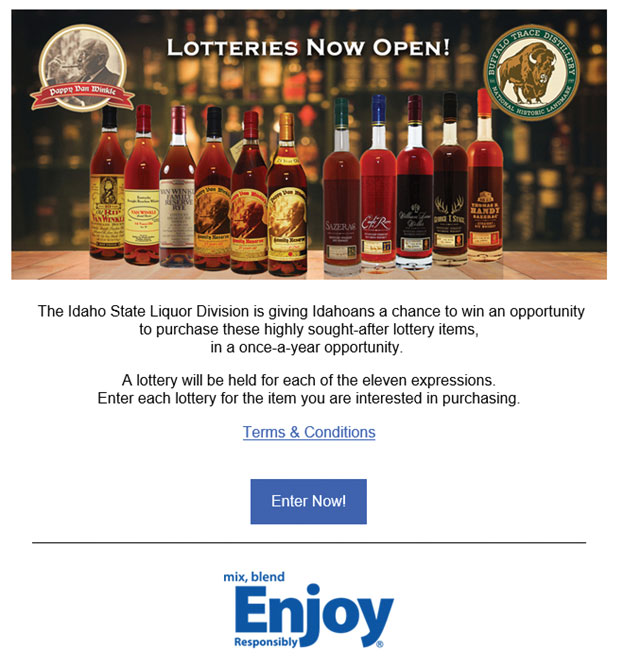
Once the online payment is made, it automatically triggers the warehouse that an item may be pulled and shipped to the appropriate store. The online tool also links to the retail store point-of-sale system, so once the bottle arrives, the store associate can receive it into the inventory and complete the transaction once the customer comes to pick it up.
The ISLD has run lotteries for several years; however, each step of the old process was manual and purchases were made at the store location. Because of this, several items were not picked up and/or forfeited, making transfers and administrative actions complicated.
This new online tool has also aided in loss prevention, since the ISLD is now able to track the status of the item online. Forfeited bottles at the store level have now been nearly eliminated, and administrative action is less cumbersome to process.
Communication to the customers has also improved, as people are now notified throughout the entire process, including once the bottle arrives at the store and is ready for pickup. The ISLD tested the program with two small lotteries, then used it during the Pappy Van Winkle lotteries in January of 2023. The program proved a success.
Best Distribution/Warehouse Innovation
Idaho State Liquor Division
By Krystina Skibo
In April 2022, the Idaho State Liquor Division (ISLD) was approaching full capacity in the current warehouse facility — 98% capacity. The team quickly needed to determine facility options and fix current capacity issues for continued growth.
“Immense growth in the Gem State’s population coupled with the pandemic exposed gaps in our warehouse operations,” says Jeff Anderson, Agency Director, Idaho Lottery and Idaho State Liquor Division. “Volumes increased substantially over the last several years. It appeared we were reaching capacity in our distribution center, prompting discussions about the need for a new facility.”
To maximize space in the warehouse, the ISLD evaluated short- and long-term goals. The first step in this process was to manage inbound freight with Open Dock, an online freight scheduling system, in July 2022. This platform allows Supplier/Logistics Companies to schedule their own appointments and lock in future appointments to maintain inventory levels.
With this new system, the ISLD requires suppliers to include load information with their appointment. The agency team then reviews all truckloads 14 days prior to arrival to ensure they are not receiving anything in excess.
Through the system, the ISLD has been able to stop suppliers from shipping items to fill a truck, and focus on inventory that is needed in the warehouse. It has also been able to track supplier freight performance through the data collected in Open Dock, which will be a tracking tool and data source for the agency’s upcoming Scorecard.
The ISLD was able to get ahead of loads with unnecessary inventory meant to “fill the truck.” The warehouse team also utilized the annual inventory audit to rerack and install new racks in the warehouse to add 141 more locations. This makes a total of 1,447 locations.
In the most recent phase of maximizing warehouse space, the ISLD ran data on which items were overstocked, and how many additional warehouse locations they were occupying. It deemed this excess inventory and required suppliers pick up the products, getting levels down to six to eight weeks of inventory.
“Team Idaho Spirits is innovative and willing to try new approaches,” says Anderson. “By listening to other control states and incorporating their best practices, such as supplier scorecards and investing in an online freight scheduling system, we have extended the life of our facility in a meaningful way.”
“We changed our racking that improved picking flow, reinforced limits on bailment inventory and instituted direct-to-store-delivery for nearly all items that can be delivered by private-sector wholesalers,” Anderson adds.
The ISLD started with 232 SKUS/491 excess pallets in February 2023 and has been able to reduce this by 90.23% in excess pallets and 89.23% in total SKUS, for a total of 25 SKUS/48 excess pallets. The total cases were lowered to 81% capacity at the conclusion of March 2023 and has reached a capacity of 76.55% today.
The ISLD’s future in this space has been extended by the efforts, while the team strategizes for future growth in distribution and what the facility needs will become.
“These combined efforts created 20% more space in the warehouse. It’s a big number,” Anderson says. “Credit goes to our procurement and distribution team. The collaboration of many saved the state valuable resources.”
Best Retail Innovation
New Hampshire Liquor Commission
By Kyle Swartz
The holiday season is New Hampshire Liquor Commission’s second-busiest sales period — and an ideal time to engage customers, support brand awareness and drive sales. For the 2022 holiday season, NHLC launched “‘Tis the Season,” an omni-channel campaign designed to engage customers with special attention to social and video, capture email addresses and reinforce sponsor brands (Tito’s & SIMI Winery).
“‘Tis The Season was a bold campaign with multiple touchpoints,” says NHLC Chairman Joseph Mollica. “All the channels worked together to generate excitement with customers and drive them into outlet locations to be part of the program.”
“Social media was a key component in creating excitement around the program, driving people online to the website and at retail to the outlet locations,” Mollica adds. “In addition to strong Facebook, Instagram, and Twitter engagements, we focused on growing our YouTube audience. Our ‘Tis The Season video series generated 13,000 views and drove a 54% increase in YouTube subscribers. Between scratch game signups (10,788), the bellyband teaser campaign (448) and Ski Journal contest (500), we grew our email list by 12,000.”
The campaign was kicked off with a teaser: a ‘Tis The Season branded belly-band for a regional print publication with a QR code, driving readers to sign up for updates, emails and video launches. The campaign officially launched at Thanksgiving with the first of six videos and a targeted announcement email to our existing email list.
Holiday guides were shipped and landed in homes on the same day the first video launched, while the campaign kicked off in our 66 NH Liquor & Wine Outlets with posters, holiday music and holiday videos embedded in the TV stream. Customers who purchased more than $25 in product were given a scratch game at the register, and holiday guides were available to all customers while shopping in the outlets. The campaign also included traditional radio, digital and print advertising.
The NHLC collected new email addresses as players entered in their winning letters, emails that were used to remind players how close they were to winning, and to encourage continued play (and return visits to the store).
At the end of the campaign, a “Thank-you for playing” email went out, along with a gift card for a wine tote, encouraging customers to return to the stores again.
“The opportunity to win prizes creates excitement for the consumer and encourages repeat visits to the outlets,” says Mollica. “More visits mean more chances to win. The scratch tickets featured both an instant-win component and a collect-and-win component. The process of scratching off the tickets is engaging. The instant-win component means that consumers are always one visit away from winning. The collect-and-win component encourages multiple visits.”
The campaign was a resounding success, the commission reports. Multiple emails were sent to the NHLC database of more than 213,000 subscribers, resulting in a 52% increase of traffic to the commission’s website. More than 28,000 holiday guides were distributed, with a readership of 42,000. Nearly 10,800 email addresses were collected. The video series emails drove over 12,400 YouTube views — representing 90% of views during the promotional period. Digital media and ads garnered approached 3 million impressions.
What’s next for such a successful program?
“In 2023, we will build on the success of ‘Tis The Season by using what we learned from 2022 and doing it even bigger,” Mollica says. “We will use similar tactics to engage with consumers and drive them into the outlet locations. Understanding an opportunity to grow sales through the gift card channel, we will put more of a focus on gift card sales, with specific promotions that reward both the buyer and the receiver.”
Best On-Premise Partnership
New Hampshire Liquor Commission
By Kyle Swartz
With the demand for premium non-alcohlic options continuing to grow, the New Hampshire Liquor Commission (NHLC) founded New Hampshire Mocktail Month to emphasize the need for a safe, responsible and inclusive drinking culture for all consumers.
Together with Brown-Forman, NHLC launched New Hampshire Mocktail Month for the third year in a row in January 2023. The campaign saw significant growth this year, with more restaurant participation, greater consumer engagement and significant media coverage, the commission reports. A record 35 New Hampshire restaurants offered alcohol-free libations, or mocktails, to customers during the 2023 New Hampshire Mocktail Month.
Why the success? “Teamwork has been essential,” says NHLC Chairman Joseph Mollica. “While NHLC and Brown-Forman are the headliners, responsibility is a team sport. RNDC has played an essential role in recruiting licensees to participate in the program. We’ve also had several great partners over the years, including Tim Laird, America’s CEO – Chief Entertaining Officer and Jessie Hawkins, Founder of The Mocktail Project.”
To encourage restaurants to participate in New Hampshire Mocktail Month, NHLC offered the opportunity to save 15% on a single NH Liquor and Wine Outlet purchase up to $10,000. In addition to New Hampshire restaurants, NHLC partnered with multiple Brown-Forman brands, including Herradura, Ford’s Gin, Finlandia Vodka, Old Forester Bourbon and Chambord.
New Hampshire Mocktail Month originated from a collaboration between NHLC and Brown-Forman called “Live Free & Host Responsibly,” an award-winning initiative that launched in 2016 in order to promote responsible alcohol service and consumption in the Granite State.
“Innovation has been key to keeping the program relevant and growing,” Mollica explains. “Live Free and Host Responsibly has evolved significantly over the past seven years, and we ultimately introduced NH Mocktail Month, which is celebrated each January.”
“Our licensees have really embraced the cause as well,” Mollica adds. “They want to create a welcoming and safe atmosphere for everyone that visits their establishment. Offering mocktails is a great way for non-drinkers to enjoy their experience and it also provides those who choose to imbibe the chance to pause and extend their evening in a responsible manner. Plus, it’s good business! Mocktails can be profitable.”
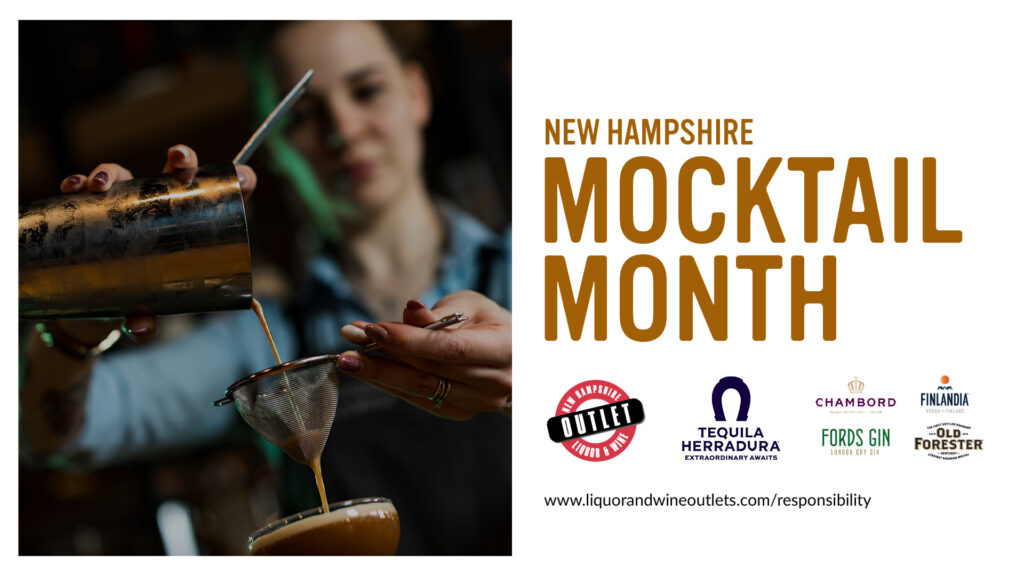
As part of New Hampshire Mocktail Month, NHLC created an online recipe guide for those who prefer to sip on their mocktails at home. The recipe guide featured mocktails from each restaurant that participated in the month-long celebration, complete with all the ingredients, garnishes and tips needed to craft a drink at home. For each mocktail, there was also a cocktail variation available, incorporating Brown-Forman brands. The recipe guide is featured on NHLC’s Live Free and Host Responsibly webpage: liquorandwineoutlets.com/responsibility.
NHLC also invited those who visited participating New Hampshire Mocktail Month restaurants to share their experiences by posting photos of their mocktail on social media, tagging @nhliquorwine and adding the hashtag #NHMocktailMonth.
“We saw significant growth this year in the number of participating restaurants, and we see no signs of stopping,” says Mollica. “Next year we’ll aim for even more restaurants, wider awareness and even tastier mocktails!”
New Hampshire Mocktail Month was a major draw for media, as it was featured in 10 articles, generating a total reach (print circulation and unique visitors to websites where online articles appeared) of more than 2 million and a total ad value (earned media value of online, print and broadcast clips) of more than $31,000.
NHLC and Brown-Forman plan to continue to collaborate to create a healthy environment for individuals who prefer mocktails, and will collectively continue to encourage a safe and responsible drinking environment throughout New Hampshire.

